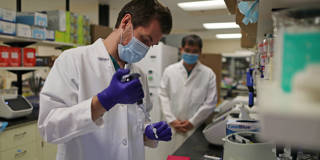Beyond COVID-19, there are innumerable other animal-borne viruses that could become new human viruses capable of causing global devastation. But not nearly enough is being done to identify the riskiest.
FAIRFIELD COUNTY, CONNECTICUT – Although COVID-19 restrictions are rapidly fading around the world, we are still reeling from the impact of the past three years. More than 6.8 million deaths from COVID-19 have been officially reported, but the true number may be closer to 15 million. There has been immense suffering and social and economic turmoil, and the virus itself still poses a clear and present risk, with one in five Americans reporting ongoing “long COVID” symptoms.
Worse, COVID-19 is far from the last zoonotic disease with the potential to devastate the global population. Innumerable other viruses – many of which remain understudied – have been discovered in animals. Any of them could serve as a source of new human viruses, which often originate from repeat-offender virus families such as coronaviruses, orthomyxoviruses, and filoviruses. When viruses from these families show up in mammals or birds, there is always a risk that they could develop the potential to infect humans. And when that happens, the fact of globalization means that those viruses can spread faster than ever before.
A key challenge, then, is to discover and identify which viruses pose the greatest risks to humans. If we can detect a new human virus in the earliest days of a disease outbreak, we will have a much better chance of implementing the measures needed to prevent another global pandemic. To that end, a recent article in Science proposes setting up an experimental pipeline whereby researchers can test animal viruses for four crucial properties consistent with human infection.

FAIRFIELD COUNTY, CONNECTICUT – Although COVID-19 restrictions are rapidly fading around the world, we are still reeling from the impact of the past three years. More than 6.8 million deaths from COVID-19 have been officially reported, but the true number may be closer to 15 million. There has been immense suffering and social and economic turmoil, and the virus itself still poses a clear and present risk, with one in five Americans reporting ongoing “long COVID” symptoms.
Worse, COVID-19 is far from the last zoonotic disease with the potential to devastate the global population. Innumerable other viruses – many of which remain understudied – have been discovered in animals. Any of them could serve as a source of new human viruses, which often originate from repeat-offender virus families such as coronaviruses, orthomyxoviruses, and filoviruses. When viruses from these families show up in mammals or birds, there is always a risk that they could develop the potential to infect humans. And when that happens, the fact of globalization means that those viruses can spread faster than ever before.
A key challenge, then, is to discover and identify which viruses pose the greatest risks to humans. If we can detect a new human virus in the earliest days of a disease outbreak, we will have a much better chance of implementing the measures needed to prevent another global pandemic. To that end, a recent article in Science proposes setting up an experimental pipeline whereby researchers can test animal viruses for four crucial properties consistent with human infection.